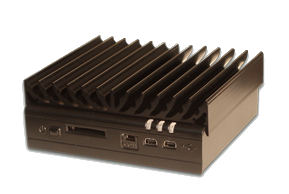After a few months working in our labs we want to introduce you to the FitVT, our low cost/low power server for the Village Telco based on FitPC2i low power computer.
After testing different low power solutions based on commodity laptops, we discovered the FitPC1. The Fitpc2i comes with two Gigabit network interfaces and the CompuLab SBC-FITPC2 series board that uses a fanless Atom Z550 32bits CPU.
In most of the scenarios the VT server will sit behind a village telco super-node and the Internet. Although we have tested commodity laptops using a USB-Ethernet converter as second interface, we have seen very bad performance in the data transfers of some USB dongles (USB 1.1). So if you plan to provide also Internet access from the mesh nodes, consider a solution with two built-in network interfaces.
Installing Ubuntu 10.04 in the fitpc2i2 was as easy as installing Ubuntu in any other computer. Use a bootable USB image or attach an external USB-CD Drive. Just make sure that you choose a 32 bits image as the Atom CPU runs 32 bits.
In our laboratory we have tested the Fitpc2i with a Intel(R) Atom(TM) CPU Z550@ 2.00GHz3 and 2 GB of RAM. The unit runs at 35-40 C when idle so make sure that you do not forget it under a pile of books as I did. There are at least two revisions of this hardware but the process of installation should be the same.
CompuLab, the company behind the FiTVT provides support for Linux Mint as the hardware seems to be targeted to those that want to run a nice multimedia station at home (i.e. stream audio/video obtained from good friends to a television). We warned that the unit does not come with VGA output and has a DVI Digital output up to 1920 x 1200 through HDMI connector instead, so you will need a LCD/TV screen with HDMI or DVI input to connect the FitPC.
There are two useful accessories that you can consider, an analog VGA converter is powered from the DVI port and requires no external power source and the external heat-sink.
The main glitch in the installation process is that the stock kernel that ships with Ubuntu 10.04 has buggy R8169 network driver that has broken auto-negotation. In my case, only one of the interfaces was able to negotiate the speed, while the other interface required the ethtool to force the speed to 10 Mbps. Fixing the speed of the second card to 10 Mbps was the only solution so as you can upgrade your kernel.
Once you upgrade the kernel from version 2.6.32-33 to 2.6.32-38 you will discover that the DADHI drivers that are used Asterisk are now broken and you will have to rebuild them. The DADHI drivers depend on kernel version (i.e. wrong symbols). In a nutshell, in order to get the network cards to work you will have to (1) upgrade your kernel and (2) rebuild DADHI Asterisk drivers.
In the second part of this article we will describe how to get the Village Telco software bundle installed.

